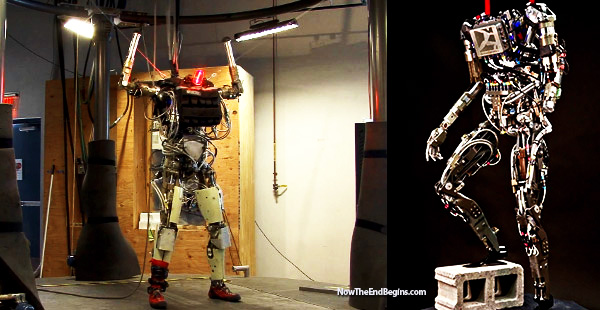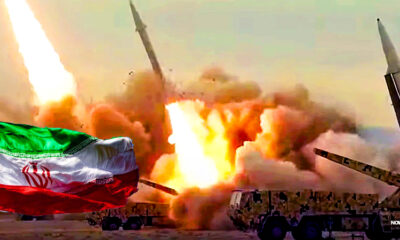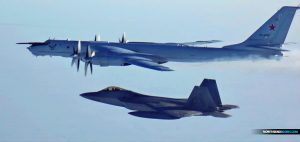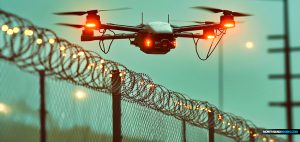DARPA
Pentagon’s DARPA Laying Framework For Creating A Robotic Army
The ultimate goal is to increase the “persistence, protection, and endurance” of military robots, which will in turn “decrease physical and cognitive workloads on our warfighters, while increasing their combat capabilities,” the Pentagon report notes.

At a NASCAR racetrack in Miami earlier this month, teams from NASA, Google, and 14 other groups of engineering gurus put cutting-edge robots through some challenging paces. The aim was to see how well the robots could tackle tasks that may sound simple, but are tricky for non-humans – including, say, climbing a ladder, unscrewing a hose from a spigot, navigating over rubble, and steering a car.

“It’s not going to be man versus machine or machine overtaking man. It’s not going to be an ‘us’ versus ‘them,’ ” he adds. “It’s going to be a ‘we.’ ”
The contest was dreamed up by the Pentagon’s futuristic experimentation arm, the Defense Advanced Research Projects Agency (DARPA), and senior defense officials were watching it carefully – well aware that the Pentagon is growing increasingly reliant on robotics.
The Defense Department will become even more reliant on such devices in the decades to come. That’s the conclusion of a new blueprint quietly released by the Pentagon this week, which offers some telling clues about the future of unmanned systems – in other words, drones and robots.
The study, the Unmanned Systems Integrated Roadmap, is meant to provide the Pentagon with a “technological vision” for the next 25 years – a vision that will be “critical to future success” of the US military, according to its authors.
Obama’s Private Army from Now The End Begins on Vimeo.
“Over the past decade, the qualities and types of unmanned systems acquired by the military departments have grown, and their capabilities have become integral to warfighter operations,” the study notes. “The size, sophistication, and cost of the unmanned systems portfolio have grown to rival traditional manned systems.”
In the future, the ideal robots will be able to take on “the ‘four D’s’ – jobs that are dirty, dangerous, dull, and difficult” for the US military, says Michael Toscano, president and CEO of the Association for Unmanned Vehicle Systems International in Arlington, Va.
The DARPA competition, for example, was inspired by the meltdown at the Fukushima Daiichi nuclear plant in Japan, when workers risked radiation poisoning to try to shut off a key valve.
The US Army and Marine Corps have for years used robots to dismantle roadside bombs inAmerica’s wars, and the DOD is developing pack robots like BigDog – designed by Boston Dynamics, a firm recently purchased by Google – to haul soldiers’ gear in the steep and rocky mountains of Afghanistan.
The Pentagon’s unmanned systems road map signals that the Pentagon will continue to deepen its forays into robotics and artificial intelligence for use on land, in the air, and at sea.
The Navy wants more unmanned underwater vehicles to act as small scouting submarines, able to perform tasks like US port security, enemy port scouting, and the surveying of depths that humans simply can’t reach.
The Air Force wants stealth drones that can operate not only in places like Afghanistan, where the Taliban has no planes or missile systems that could pose a threat to US aircraft, but also in “contested environments,” above countries that do have sophisticated air defense systems.
Within all the services, one considerable engineering challenge for unmanned systems is in the cyber realm: making sure encryption is good enough for protecting data streams that are crucial to the operations of drones and robots.
The ultimate goal is to increase the “persistence, protection, and endurance” of military robots, which will in turn “decrease physical and cognitive workloads on our warfighters, while increasing their combat capabilities,” the Pentagon report notes. “The end state is an affordable, modernized force as a manned-unmanned team with improved movement and maneuver, protection, intelligence, and sustainment.”
Back at the NASCAR speedway, the 16 robot teams completed the tasks with varying degrees of success and were scored on a point system. The eight winners, which included teams from Google – including Google’s new purchase, Boston Dynamics – will come together again next December for a $2 million prize.
In the US military of 2014 and beyond – and in the commercial realms – there is likely to be “more of an interaction between man and artificial intelligence and robotics,” Mr. Toscano says. “There’s a high probability that it’ll be a relationship of man and machine collaboratively living and working together.”
This might include sending robots into burning forests that would risk the lives of human firefighters and even using robotic animals like moose that could infiltrate a herd to help monitor migration patterns. “These are magical things,” Toscano says. “This is imagination.”
Google’s purchase last month of Boston Dynamics, the company that makes BigDog and other military robots, shows how commercial companies are increasingly believing in the power of robotics to drive innovations. “Companies like Google always go after the cream of the crop – the big thinkers – in search of where the next great invention is going to come from,” Toscano notes.
“It’s not going to be man versus machine or machine overtaking man. It’s not going to be an ‘us’ versus ‘them,’ ” he adds. “It’s going to be a ‘we.’ ” source – CS Monitor

DARPA
Super-Secret Spy Technology Group DARPA Creates New War Program Called ‘In The Moment’ Which Will Allow AI To Make Battlefield Decisions
Through a new program, called In the Moment, DARPA wants to develop technology that would make quick decisions in stressful situations using algorithms and data, arguing that removing human biases may save lives, according to details from the program’s launch this month. “DARPA envisions a future in which machines are more than just tools,” the agency said in announcing the AI Next program. “The machines DARPA envisions will function more as colleagues than as tools.”

The Defense Advanced Research Projects Agency DARPA – the innovation arm of the U.S. military – is aiming to answer these thorny questions by outsourcing the decision-making process to artificial intelligence.
On the surface, the idea of DARPA AI making split-second decisions on the battlefield in the time of war might seem like a good idea. On the other hand, the idea of DARPA AI making split-second decisions on the battlefield in the time of war seems like a terrible idea. What this actually is is another giant step towards having autonomous robot armies who can fire weapons at their own discretion. Feeling safe, yet?
“They come from a far country, from the end of heaven, even the LORD, and the weapons of his indignation, to destroy the whole land.” Isaiah 13:5 (KJB)
Here’s a DARPA fun fact, the same man who created the Defense Advanced Research Projects Agency, President Dwight D. Eisenhower, is the exact same man who also warned us about the Military Industrial Complex. How’s that for irony? When it finally all comes down, it will be DARPA inserting the microchips in the back of people’s right hand. They do a lot of work with microchips in the brain right now. DARPA was also instrumental with the COVID vaccine, so you do the math, but I see how it all adds up.
The military wants DARPA AI to replace human decision-making in battle
FROM GREENWICH TIME: Through a new program, called In the Moment, it wants to develop technology that would make quick decisions in stressful situations using algorithms and data, arguing that removing human biases may save lives, according to details from the program’s launch this month.
Though the program is in its infancy, it comes as other countries try to update a centuries-old system of medical triage, and as the U.S. military increasingly leans on technology to limit human error in war. But the solution raises red flags among some experts and ethicists who wonder if AI should be involved when lives are at stake.
“AI is great at counting things,” Sally A. Applin, a research fellow and consultant who studies the intersection between people, algorithms and ethics, said in reference to the DARPA program. “But I think it could set a precedent by which the decision for someone’s life is put in the hands of a machine.”
Founded in 1958 by President Dwight D. Eisenhower, DARPA is among the most influential organizations in technology research, spawning projects that have played a role in numerous innovations, including the Internet, GPS, weather satellites and, more recently, Moderna’s coronavirus vaccine. But its history with AI has mirrored the field’s ups and downs. In 1960s, the agency made advances in natural language processing, and getting computers to play games such as chess. During the 1970s and 1980s, progress stalled, notably due to the limits in computing power.
“DARPA envisions a future in which machines are more than just tools,” the agency said in announcing the AI Next program. “The machines DARPA envisions will function more as colleagues than as tools.”
Since the 2000s, as graphics cards have improved, computing power has become cheaper and cloud computing has boomed, the agency has seen a resurgence in using artificial intelligence for military applications. In 2018, it dedicated $2 billion, through a program called AI Next, to incorporate AI in over 60 defense projects, signifying how central the science could be for future fighters. READ MORE
Listen To This From The Man That Created DARPA
On Jan. 17, 1961, President Dwight Eisenhower gave the nation a dire warning about what he described as a threat to democratic government. He called it the military-industrial complex, a formidable union of defense contractors and the armed forces. We urge you to watch the entire speech in it’s context, but the good stuff begins at the 06:45 mark.
This Is Where DARPA Is Ultimately Heading
What you are watching is a clip from the 1999 movie Revelation 2: Apocalypse. As with most Christian movies from that time period, the acting is so-so, and the production values mediocre. But what will BLOW YOU AWAY is watching how they connect the Mark of the Beast with Virtual Reality, and then reading this story on Facebook buying CTRL-Labs so they can add thought control to their Virtual Reality Oculus.
Now The End Begins is your front line defense against the rising tide of darkness in the last Days before the Rapture of the Church
- HOW TO DONATE: Click here to view our WayGiver Funding page
When you contribute to this fundraising effort, you are helping us to do what the Lord called us to do. The money you send in goes primarily to the overall daily operations of this site. When people ask for Bibles, we send them out at no charge. When people write in and say how much they would like gospel tracts but cannot afford them, we send them a box at no cost to them for either the tracts or the shipping, no matter where they are in the world. Even all the way to South Africa. We even restarted our weekly radio Bible study on Sunday nights again, thanks to your generous donations. All this is possible because YOU pray for us, YOU support us, and YOU give so we can continue growing.
But whatever you do, don’t do nothing. Time is short and we need your help right now. If every one of the 15,860+ people on our daily mailing list gave $4.50, we would reach our goal immediately. If every one of our 150,000+ followers on Facebook gave $1.00 each, we would reach 300% of our goal. The same goes for our 15,900 followers on Twitter. But sadly, many will not give, so we need the ones who can and who will give to be generous. As generous as possible.
“Looking for that blessed hope, and the glorious appearing of the great God and our Saviour Jesus Christ;” Titus 2:13 (KJV)
“Thank you very much!” – Geoffrey, editor-in-chief, NTEB
- HOW TO DONATE: Click here to view our WayGiver Funding page
DARPA
First-Ever Fully Autonomous DARPA Black Hawk Helicopter Takes To The Skies Without Pilot In Frightening Harbinger Of Soulless Robot Armies
A fully autonomous DARPA and Lockheed Martin Black Hawk helicopter takes to the skies without a pilot for the first time in dystopian vision.

A fully autonomous DARPA Black Hawk helicopter has taken to the skies over the US without a human pilot on board for the first time in modern history.
In most dystopian visions of the future, we picture pilotless aircraft flying overhead using laser-guided missiles to destroy as legions of robot soldiers go from house to house, stomping on citizens who are trying in vain to plead for their lives. This week, a Black Hawk helicopter, using software and hardware created in a joint alliance between super-secret Army research group DARPA and Lockheed Martin, successfully flew without a human pilot, completing the mission and landing itself without a hitch.
“Behold ye among the heathen, and regard, and wonder marvellously: for I will work a work in your days, which ye will not believe, though it be told you.” Habakkuk 1:5 (KJB)
This is the world, pulled from the pages of Revelation, that is rushing towards us at a thousand miles per hour, without absolutely no hope of it missing its target. Autonomous vehicles are a must in the coming economy of Antichrist where, without the Mark of the Beast, you will not be allowed access to anything, especially not to your vehicles that could be used to fight against him. In the meantime, this technology is being sold as something that will create better ‘safety and security’, cutting down on crashes and accidents, and I’m sure it will be a blessing, right up to the moment it’s not.
Fully autonomous DARPA Black Hawk helicopter takes to the skies without a pilot for the first time
FROM THE DAILY MAIL UK: A partnership between Lockheed Martin Sikorsky and the Defence Armed Research Projects Agency (DARPA), it took off from Fort Campbell in Kentucky on February 5. Without anyone on board, the UH-60A Black Hawk completed a 30 minute flight above the US army installation, with a second flight held on February 7. It comes with an optionally piloted cockpit, that has to be switched from pilot, to autonomous mode – allowing an onboard computer brain to control the vehicle.
During the flight the Aircrew Labor In-Cockpit Automation System (ALIAS) autonomous pilot was presented with a series of simulated obstacles to overcome. It had to execute a series of pedal turns, maneuvers and straightaways before carrying out a perfect landing back on the Fort Campbell runway – without any human intervention. The autonomous helicopter could be used to deliver supplies to dangerous war zones, or recover soldiers without risking a pilot.
‘This historic BLACK HAWK flight marks the first time that a UH-60 has flown autonomously and builds on recent demonstrations at the U.S. Army’s Project Convergence 2021,’ a Lockheed Martin spokesperson said in a statement.
Once it had shut itself down and the blades had stopped spinning, a pair of pilots entered the vehicle, switched it back to human mode and took it back to base.
This wasn’t the first time the ALIAS system has been tested during a flight, and wasn’t the first time it had been used in a Black Hawk, but was the first time they’d trusted the autopilot to fly and land with no humans as a backup. One example of use could be for pilots flying into an area where visibility suddenly becomes a problem, flipping the switch to autonomous mode allows the ALIAS system to take over, using sensors rather than sight to navigate.
Benjamin Williamson, lead test pilot for the Fort Campbell event, said: ‘This capability will allow pilots to confidently switch back and forth between autonomy and piloted modes at any point of their mission with the literal flip of a switch. This will support autonomous flight during a wide range of missions such as flight in degraded visual environments (DVE) and confined areas. Most critically, ALIAS will be capable of automatically detecting and preventing dangerous situations that lead to accidents, thereby saving lives.’
Most autonomous systems used in aircraft to date have acted as an assistant to pilots, carrying out simple tasks, but leaving complex and unexpected situations to the human.
However, ALIAS turned a basic Black Hawk into an aircraft that is completely autonomous, with the on-board brain able to handle all aspects of flight. This includes pre-flight procedures, including power, secondary control, wind checks and other elements, as well as the flight and landing – even in an emergency. If there had been a problem during the test flight, going as far as both engines failing, it would have found a safe landing spot and touched down, without human input. READ MORE
First Pilotless DARPA Black Hawk Helicopter Flight
Sitting on the runway in Fort Campbell, Kentucky, one of Sikorsky’s pilots in an S-70™ BLACK HAWK® helicopter flips the optionally piloted cockpit switch from two to zero, exits the aircraft and walks across the runway.
Now The End Begins is your front line defense against the rising tide of darkness in the last Days before the Rapture of the Church
- HOW TO DONATE: Click here to view our WayGiver Funding page
When you contribute to this fundraising effort, you are helping us to do what the Lord called us to do. The money you send in goes primarily to the overall daily operations of this site. When people ask for Bibles, we send them out at no charge. When people write in and say how much they would like gospel tracts but cannot afford them, we send them a box at no cost to them for either the tracts or the shipping, no matter where they are in the world. Even all the way to South Africa. We even restarted our weekly radio Bible study on Sunday nights again, thanks to your generous donations. All this is possible because YOU pray for us, YOU support us, and YOU give so we can continue growing.
But whatever you do, don’t do nothing. Time is short and we need your help right now. If every one of the 15,860+ people on our daily mailing list gave $4.50, we would reach our goal immediately. If every one of our 150,000+ followers on Facebook gave $1.00 each, we would reach 300% of our goal. The same goes for our 16,400 followers on Twitter. But sadly, many will not give, so we need the ones who can and who will give to be generous. As generous as possible.
“Looking for that blessed hope, and the glorious appearing of the great God and our Saviour Jesus Christ;” Titus 2:13 (KJV)
“Thank you very much!” – Geoffrey, editor-in-chief, NTEB
- HOW TO DONATE: Click here to view our WayGiver Funding page
DARPA
DARPA Building Nuclear Powered Atomic Rocket To Deploy Satellites Into Deep Cislunar Space Before China Is Able To Get Their With Own Spacecraft
U.S. government secret project agency DARPA is working on an atomic rocket to send satellites into the vast space between Earth and the moon ahead of China.

The U.S. government secret project agency DARPA is working on an atomic rocket to send satellites into the vast space between Earth and the moon—before Beijing gets there with its own spacecraft.
Regular readers of NTEB are well aware of DARPA, or the Defense Advanced Research Projects Agency, which is the brains behind all sorts of interesting projects. Really cool stuff like high-altitude surveillance balloons, implantable RFID microchips in the brain, and armies made from robot soldiers. Yeah, DARPA is pretty interesting to say the least.
Now DARPA is asking the Pentagon to give them lots of money to create an atomic rocket capable of launching satellites in the deep cislunar space between Earth and the moon, and they want to do it before the Chinese get there with their own spacecraft. Certainly the nation that could control that area of space would wield a lot of power in the cyber age where wars are fought with drones and computers. DARPA is always up to something, which is we are always watching DARPA. Game on.
DARPA Wants Millions For Demonstration Rocket for Agile Cislunar Operations Program
FROM THE DAILY BEAST: The Pentagon and DARPA want to extend the reach of its satellites tens of thousands miles toward the moon. And it’s working on a high-tech, atomic-powered “nuclear thermal propulsion” engine to make it possible.
The military’s goal is to deploy maneuverable satellites into the vast space between the Earth and the moon—“cislunar” space, it’s called—before China gets there with its own spacecraft. But this isn’t the first time the U.S. government has tried to develop an atomic rocket. And there’s no guarantee the same problems that ended previous efforts won’t also scuttle this one.
“The capability afforded by [nuclear thermal propulsion] will expand the operating presence of the U.S. in space to the cislunar volume and enhance domestic operations to a new high-ground, which is in danger of being defined by the adversary,” the Defense Advanced Research Projects Agency, or DARPA, which oversees the atomic rocket effort, explained in its budget proposal.
The U.S. and Chinese space agencies and even private corporations are eager to mine the moon for minerals that could support deep-space missions, potentially including humanity’s first trip to Mars.
“An agile nuclear thermal propulsion vehicle enables the Defense Department to maintain space domain awareness of the burgeoning activity within this vast volume,” Jared Adams, a DARPA spokesperson, told The Daily Beast.
DARPA budget request for 2021, which the agency released in early February, asks for $21 million for the “Demonstration Rocket for Agile Cislunar Operations” program, or DRACO.
Congress gave DARPA $10 million in 2020 to start studying the DRACO engine. The 2021 budget would allow the agency to start building components. The plan is for DARPA to test DRACO before handing it over to the U.S. Air Force for routine operations.
The military’s nuclear thermal propulsion project is a virtual twin of a similar NASA program that’s a couple of years older.
DRACO is what experts call a “high-assay low-enriched uranium nuclear-thermal propulsion system.” Basically, it’s a small nuclear reactor atop a space rocket. The reactor heats up a propellant—hydrogen, for example—that accelerates through a nozzle, pushing the satellite in the opposite direction.
Nuclear-thermal engines aren’t for launching from Earth’s surface. They’re for cruising long distances through space or maneuvering a lot while keeping closer to Earth.
The moon is 240,000 miles from Earth. Most man-made satellites orbit no more than a few thousand miles from Earth’s surface. The United States and China are both in a scramble to fill that gap. READ MORE
3 Of The Strangest Projects DARPA Has Worked On
DARPA, or the Defense Advanced Research Projects Agency, is tasked with exploring some far out science and technology projects to benefit the United States. Since its inception in 1958, it’s been credited with a number of inventions you probably use every day, but it also has worked on some weird stuff that never really came to fruition.
The ABCs of DARPA
DARPA, the Defense Advanced Research Projects Agency, is known for the wide range of research and development programs it runs to open pathways toward technologies that can further the cause of national security. Each program is most often known by its very own acronym, so for all those returning to school, or just to their normal post-summer routines, DARPA offers its own version of the ABCs.
Now The End Begins is your front line defense against the rising tide of darkness in the last days before the Rapture of the Church
- HOW TO DONATE:Click here to view our GoFundMe page
When you contribute to this fundraising effort, you are helping us to do what the Lord called us to do. The money you send in goes primarily to the overall daily operations of this site. When people ask for Bibles, we send them out at no charge. When people write in and say how much they would like gospel tracts but cannot afford them, we send them a box at no cost to them for either the tracts or the shipping, no matter where they are in the world. Even all the way to South Africa. We even restarted our weekly radio Bible study on Sunday nights again, thanks to your generous donations. All this is possible because YOU pray for us, YOU support us, and YOU give so we can continue growing.
But whatever you do, don’t do nothing. Time is short and we need your help right now. If every one of the 13,131 people on our daily mailing list gave $4.50, we would reach our goal immediately. If every one of our 151,781 followers on Facebook gave $1.00 each, we would reach 300% of our goal. The same goes for our 14,500 followers on Twitter. But sadly, many will not give, so we need the ones who can and who will give to be generous. As generous as possible.
“Looking for that blessed hope, and the glorious appearing of the great God and our Saviour Jesus Christ;” Titus 2:13 (KJV)
“Thank you very much!” – Geoffrey, editor-in-chief, NTEB
- HOW TO DONATE: Click here to view our GoFundMe page
-

 George Soros8 years ago
George Soros8 years agoProof Of George Soros Nazi Past Finally Comes To Light With Discovery Of Forgotten Interview
-

 Election 20168 years ago
Election 20168 years agoDEAD POOL DIVA: Huma Abedin Kept Those Hillary Emails That The FBI Found In A Folder Marked ‘Life Insurance’
-

 Election 20168 years ago
Election 20168 years agoCrooked Hillary Campaign Used A Green Screen At Today’s Low Turnout Rally In Coconut Creek FL
-

 George Soros8 years ago
George Soros8 years agoSORE LOSER: George Soros Declares War On America As Violent MoveOn.Org Protests Fill The Streets
-

 Donald Trump8 years ago
Donald Trump8 years agoDonald Trump Will Be 70 Years, 7 Months And 7 Days Old On First Full Day In Office As President
-

 Headline News8 years ago
Headline News8 years agoIf Hillary Is Not Guilty, Then Why Are Her Supporters Asking Obama To Pardon Her? Hmm…
-

 Election 20168 years ago
Election 20168 years agoWikiLeaks Shows George Soros Controlling Vote With 16 States Using SmartMatic Voting Machines
-

 End Times8 years ago
End Times8 years agoFalse Teacher Beth Moore Endorses The Late Term Partial-Birth Abortion Candidate Crooked Hillary













































































